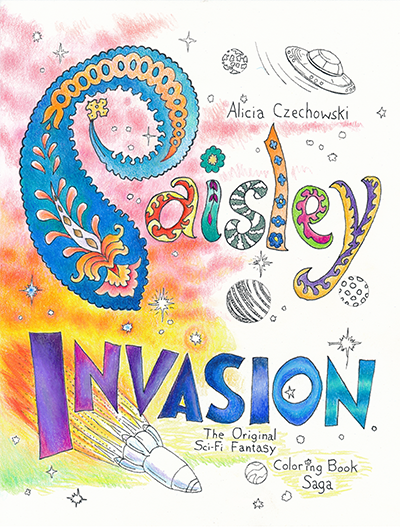 Paisley Invasion
Paisley Invasion
Paisley Invasion, Alicia Czechowski's quirky, wordless graphic novel, is subtitled "The original sci-fi fantasy coloring book saga." This interactive work reminded me of two staples of my 1970s childhood, Edward Gorey's surreal illustrated booklets and Susan Striker's Anti-Coloring Book series (anyone else remember those?).
Paisley Invasion is a sequence of images depicting Earth's invasion by mysterious life forms from an alien planet. The intricately patterned creatures look like those teardrop shapes on a paisley necktie, with a hint of the amoeba or tentacle about them, too. Humans and animals react in myriad ways. Some, mostly children, are intrigued and delighted. Dogs are anxious. Adults range from dangerously unaware (paisleys creep up on a woman in the shower—shades of Psycho!) to violent and terrified. Later they are stunned to discover the paisley taking over their very bodies. Yet this mutation holds a strange beauty and awe, for those who are open to the trans-human future.
While the vibe is definitely Summer of Love record album covers, not haunted Edwardian mansions and silent movie stills, I recognized the same spirit in Paisley Invasion as in Gorey's enigmatic Les Passementeries Horribles, a wordless book in which monstrous tassels stalk unsuspecting ladies and gentlemen. The mood of both books balances on a razor's edge between comical and sinister. You laugh, but glance nervously over your shoulder, in case one of those ornate blobs is coming for you. The absurdity can't quite dispel the tension that has no rational cause—how much harm could those things do?
It's the uncanny, all by itself, that spooks us. These floating objects have no faces for us to read their emotions, yet they seem conscious and determined. We can't understand how they could be alive, let alone what they want. Wisely, Czechowski doesn't privilege one human reaction over another. We are free to add our interpretations to the story when we color it in, like the illustrations in the Anti-Coloring Books that were deliberately incomplete so that children could make their own drawings.
The book had a sturdy binding with good-sized pages for coloring. Some of the lines in the drawings were faint, meaning that details might be lost when colored over. The images went right up to the page crease. Coloring book creators would be advised to include a small border so the user's pen can reach the edges of the picture. The thin paper had a lot of bleed-through when I tested it with a marker. I would recommend only coloring with crayons or pencils, or putting a sheet of scrap paper between your working page and the one below it if you must use ink.
Contest screener Annie Mydla passed this book on to the finals with these words: "There's got to be some message here, but I have no idea what it is and I'm content just to bask in the glow of this amazing strangeness."








